|
Its royal blue background is
reminiscent of the blue sea and clear sky surrounding NZ. The stars of
the Southern Cross emphasise the country's location in the South
Pacific Ocean.
Trading troubles. The
idea of a flag to represent New Zealand was first broached in
1830, when the Hokianga-built trading ship Sir George Murray
was seized in Sydney
by Customs officials for sailing without a flag or register.
Australia, New Zealand's major trading market, was subject to British
navigation laws which
ruled that every ship must carry an official certificate
detailing construction, ownership and nationality of the ship.
At that time, New Zealand
was not yet a British colony
and New Zealand-built ships could not sail under a British flag
or register. Without a flag to represent the new nation, trading
ships and their valuable cargoes would continue to be seized.
The seizure of the Sir George Murray
and her detainment in Neutral Bay occurred whilst two principal
Maori chiefs, believed to be Patuone and Taonui, were on board,
and reports at the time indicate that the Maori population were
'exceedingly indignant' upon hearing the news of the ship's
fate. In New South Wales also, there was sympathy for New
Zealand's plight and the weekly Australian
called for amending legislation to remove any obstacle to New
Zealand's increasing trade with Port Jackson. While a
temporary licence was granted in August 1831 allowing the Sir
George Murray to return to Sydney for trading, the need for
an official flag to mark New Zealand-built ships was clear. |
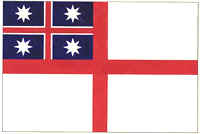 |
Flag of the
United Tribes of New Zealand (1834-1840) On 20 March
1834, 25 chiefs from the Far North and their followers gathered
at Waitangi to choose a flag to represent New Zealand. A number
of missionaries, settlers and the commanders of 10 British and 3
American ships were also in attendance at the occasion.
Following Busby's address, each chief was called forward in turn
to select a flag, while the son of one of the chiefs recorded
the votes. |
| The preferred design,
a flag already used by the Church Missionary Society, received
12 out of the 25 votes, with the other two designs receiving 10
and 3 votes respectively. Busby declared the chosen flag the
national flag of New Zealand and had it hoisted on a central
flagpole, accompanied by a 21 gun salute from HMS Alligator. |
The Union Flag gives recognition to
our historical foundations and the fact that New Zealand was once a
British colony and dominion.
The Union Jack in New Zealand
1840–1902 The Union Jack
became the official flag of New Zealand in 1840, and was used for all
appropriate occasions on shore. At sea, New Zealand was represented by
British naval or maritime flags until the Colonial Naval Defence Act
became law in 1865. The Union Jack remained New Zealand's flag until
the passing of the New Zealand Ensign Act instituted the current flag
in 1902. It continued to be used regularly in New Zealand well into
the 1950s, instead of, or in tandem with the New Zealand Flag. Today,
the Union Jack is most commonly seen in New Zealand when a member of
the Royal Family, or other distinguished British guest, is visiting.
The New Zealand Flag may be flown on
any day of the year. It is particularly appropriate to fly it on days of
national commemoration, such as Anzac Day, and on other important
occasions.
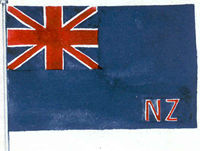 |
(1865–1902) Representing
New Zealand at sea The roots of
New Zealand's present flag lie in the Imperial Colonial Naval Defence
Act of 1865, which ruled that all ships owned by a colonial government
must fly the Blue Ensign with the badge of the colony on it. New
Zealand at that time did not have an official badge or emblem, and as
such flew the Blue Ensign without a distinguishing badge. In 1866, the
Government steamers St. Kilda and Sturt were reprimanded
by visiting British ships for flying the Blue Ensign without the
colony's badge. This embarrassment prompted the government to devise
an emblem for placement on the flag, in compliance with the Act. |
As New Zealand's national symbol the
New Zealand Flag should be treated in a manner worthy of its high
status.
The Flags, Emblems, and Names Protection Act 1981, administered
by the Ministry for Culture and Heritage, defines and protects the Flag.
Contained in the Act is the power to prosecute those who misuse it.
Description.
The New Zealand Flag features, on a royal blue background, a Union Jack
in the first quarter and four five-pointed red stars of the Southern
Cross on the fly. The stars have white borders. The New Zealand Flag may
be made to any size, but in all cases the length should be twice the
width.

Dignity of the flag. The
New Zealand Flag is the national symbol of this country and accordingly
it should be honoured and treated with respect. To use, display,
destroy, or damage the Flag in or within view of a public place with the
intention of dishonouring it is an offence, as is the placement of any
letter, emblem, or representation on the Flag.
Advertising and Commercial Use. Any
person or organisation may use the New Zealand Flag in advertising. A
faithful representation should always be achieved with the flag being
reproduced in its true form and colours. Slogans or objects appearing in
a different dimension to the Flag, within the context of an
advertisement, will not be seen as the placement of unauthorised objects
on the Flag. Persons or organisations wishing to use the New Zealand
Flag in advertisements or for commercial purposes are welcome to discuss
their ideas with the Ministry for Culture and Heritage.
Displaying the Flag. Except
when flown with royal or vice-regal flags, the New Zealand Flag should
always be given the Position of Honour in New Zealand.

Within New Zealand, the New Zealand
Flag takes precedence over all other national flags and house flags.
However, international practice forbids the display of the flag of one
nation above that of another in time of peace.
When the New Zealand Flag is flown
with the flags of other nations, each flag should be the same size and
should fly from a separate flagpole of the same height. A house flag may
fly beneath the New Zealand Flag on the same flagpole.
Flying the Flag. The
New Zealand Flag may be flown on any day of the year, usually during
normal working hours, and in a variety of places. Often, flag flying is
observed on a 24 hour basis, especially when buildings are floodlit.
Continuous flying, however, shortens the life of a flag, and it may have
to be replaced more often.

Days of National Commemoration. Flag
flying is particularly encouraged on those days of the year designated
days of national commemoration.
-
These days are:
-
February
-
March
-
April
-
June
-
October
-
24 - United Nations Day
-
4th Monday - Labour Day
-
November
*Anzac Day (25
April). Anzac Day is New Zealand's national day for commemorating
those who have served this country in times of war. The New Zealand
Flag should be flown at the top of the flagpole. It is appropriate,
however, at places where commemorative services are being held, for
the flag to be lowered to half-mast, for the duration of a memorial
service, as a sign of respect.

Other Official Occasions
Times of Mourning. Flags
are flown at half-mast as a sign of mourning.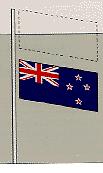
The flag is half-masted by first
raising it to the top of the mast and then immediately lowering it
slowly to the half-mast position. The half-mast position will depend on
the size of the flag and the length of the flagpole. The flag must be
lowered to a position recognisably half-mast to avoid the appearance of
a flag which has accidentally fallen away from the top of the flagpole.
The flag should always be more than its own depth from the top of the
flagpole.
On occasions when the New Zealand Flag
is flown at half-mast, it is preferable that other flags should not be
flown above it. The Flag should be raised again to the peak before being
lowered for the day.
Naval Ships and Government Vessels. Commissioned
ships of the Royal New Zealand Navy fly the New Zealand Flag as a jack
(that is at the bow) when anchored, secured to a buoy, moored, or tied
to a wharf. They also fly the New Zealand White Ensign at the stern.
Government vessels fly the New Zealand Flag as an ensign (that is at the
stern).

Merchant Ships and Pleasure Craft.
Merchant ships, pleasure boats, and yachts may fly the New Zealand Red
Ensign
Other Flags. Seven
flags other than the New Zealand Flag are shown for official purposes in
New Zealand. The most important of these are The Queen's New Zealand
Flag, the Governor-General's Flag, the New Zealand Red Ensign, the New
Zealand White Ensign, the Royal New Zealand Air Force Ensign, and the
New Zealand Civil Air Ensign.
| Queen's Personal Flag For New Zealand |
The
Queen's Personal Flag for New Zealand symbolises the fact that
Queen Elizabeth II is The Queen of New Zealand. Adopted in 1962,
it is flown only by Her Majesty when in NZ.
The Flag is the shield design of
the New Zealand Coat of Arms in the form of an oblong or square.
Superimposed in the centre is a dark blue roundel bearing a Roman
E surmounted by a Royal Crown within a garland of roses all in
gold. The Central device is from The Queen's Personal Flag which
is frequently used by Her Majesty in relation to Her position as
Head of Commonwealth.  |
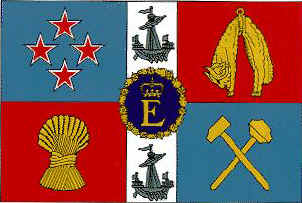 |
| The Queen's Personal
Flag for New Zealand is flown continuously on a building when The
Queen is in residence and by a ship conveying Her Majesty in New
Zealand waters. If the Queen attends a State or public function,
her personal flag is flown while she is present. It is not,
however, hoisted at every venue attended by Her Majesty. If flown
with the New Zealand Flag, The Queen's Personal Flag for New
Zealand takes the position of honour.
The Queen's Personal Flag for
New Zealand is usually flown above the saluting base at troop
inspections or other open air gatherings when Her Majesty is
present. It is also broken when the Queen sets foot on board one
of Her Majesty's New Zealand ships.
The only time The Queen's
Personal Flag for New Zealand is flown in her absence is at
parades held on and in honour of Her Majesty's Official Birthday. |
| The
Governor-General's Flag |
The flag
of the Governor-General consists of the Royal Crest in gold, red,
white and green on a royal blue ground.
The design, introduced in 1931,
is uniform throughout the Commonwealth. The words New Zealand
appear on a gold scroll beneath the crest.

|
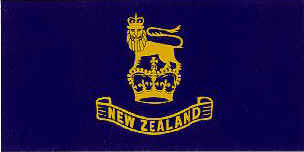 |
| The
Governor-General's flag is flown on all occasions when the
Governor-General is present, and takes precedence over the New
Zealand Flag. It is flown continuously over Government House when
the Governor-General is in residence, and on vehicles used by the
Governor-General for official occasions.
Please note that it is not possible to accurately represent
the colours of the Governor-General's flag on an image of this
size. In these cases, the detailing of the flag is shown only in
gold. |
| The
New Zealand Red Ensign |
New
Zealand Government ships must fly the New Zealand Flag.
Other New Zealand ships, other
than Government ships may fly the New Zealand Flag, the New
Zealand Red Ensign, or any flag authorised by either the Sovereign
or the Governor-General.
|
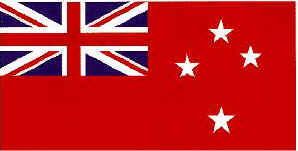 |
| The New Zealand Red
Ensign is based on the Red Ensign usually flown by merchant ships
registered in the United Kingdom. The Union Jack appears in the
first quarter, and the Southern Cross, represented by four
five-pointed white stars, is featured in the fly.
The New Zealand Red Ensign has
sometimes been flown incorrectly, both in New Zealand and
overseas, in the belief that it is this country's national flag.
However, the New Zealand Red Ensign may be flown on land in places
or on occasions of Maori significance. The Flags, Emblems, and
Names Protection Act 1981 allows for the continuation of this
traditional practice. |
| The New Zealand
White Ensign |
Ships and
commissioned shore establishments of the Royal New Zealand Navy
fly the New Zealand White Ensign.
This flag has the Union Jack in
the first quarter, on a white background. The Southern Cross,
represented by four five-pointed red stars, appears in the fly.

|
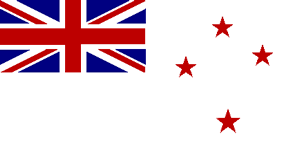 |
| In 1968 the New
Zealand White Ensign replaced the British White Ensign previously
used by New Zealand naval ships. The New Zealand White Ensign is
usually flown only during daylight hours, but in the event of war
it would be flown continuously.
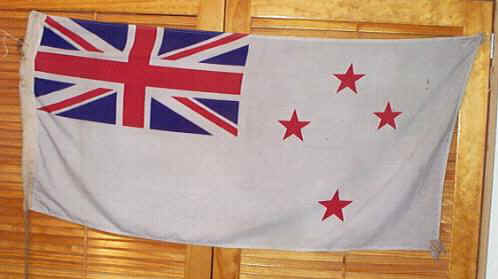
|
| Royal New Zealand Air Force Ensign |
The Royal
New Zealand Air Force Ensign is hoisted daily at Air Force
establishments.
It is also flown on Royal New
Zealand Air Force aeroplanes carrying Foreign and Commonwealth
Heads of State and Heads of Government, the Prime Minister,
Cabinet Ministers, the Chiefs of Staff, Ambassadors, and other
distinguished persons.

|
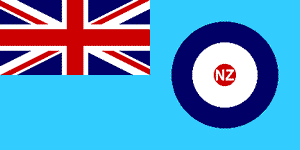 |
The
New Zealand Civil Air Ensign
|
The New
Zealand Civil Air Ensign may be flown on any New Zealand aircraft,
licensed aerodrome, or place authorised as an aerodrome.
Airlines owning New Zealand
aircraft may fly the ensign upon or in proximity to their
principal office or place of business.
The Civil Aviation Authority of
New Zealand may also fly the New Zealand Civil Air Ensign on its
buildings and aircraft. |
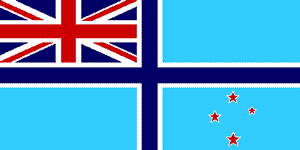 |
|